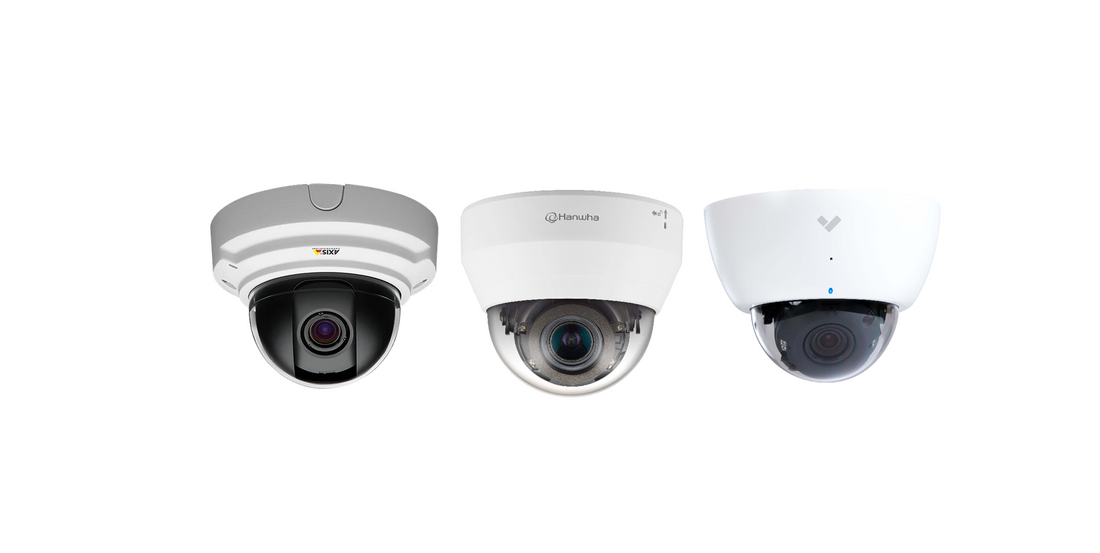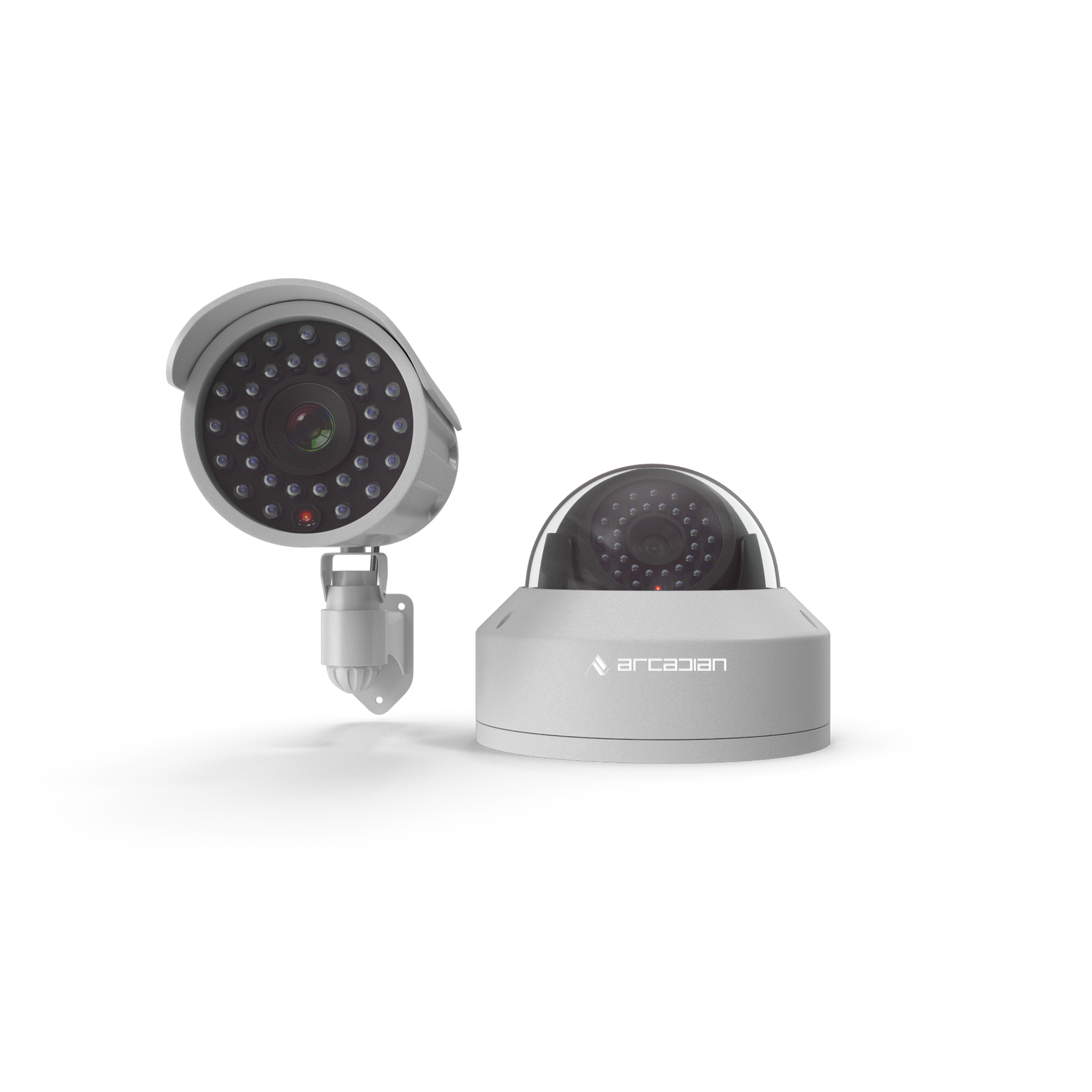Axis vs. Hanwha vs. Verkada: The Ultimate 2025 Camera Comparison for Enterprise Security
Axis, Hanwha, and Verkada dominate the security camera space in 2025—but which one is truly enterprise-ready? This blog post dissects every detail so you can make the smart switch.

- Introduction
- Quick Summary
- Background & Relevance
- Camera Model Selection for Evaluation
- Axis Q1809-LE — Specs, Strengths, Weaknesses
- Hanwha PNV-A9081R — Specs, Strengths, Weaknesses
- Verkada MV72 (Gen 2) — Specs, Strengths, Weaknesses
- Table: Core Feature Comparison
- Adaptability Across Environments
- Business Models & Ecosystem Lock-in
- ArcadianAI Advantage
- FAQ
- Conclusion
Introduction
The global video surveillance market is projected to grow from $73.8 billion in 2024 to over $147.6 billion by 2030, reflecting both the increasing demand and the expanding role of AI in enterprise security. Yet not all camera systems are built for the future. Axis, Hanwha, and Verkada represent three fundamentally different approaches to video surveillance. In this blog post, we benchmark these industry leaders—model by model, spec by spec—to help you identify which system fits best. And, critically, we’ll show you why ArcadianAI’s platform and its AI assistant Ranger offer unmatched adaptability, regardless of camera brand.
If you're using Axis Q1809-LE, Hanwha PNV-A9081R, or Verkada MV72, this post is your full comparative guide.
Quick Summary
-
Axis excels in image quality and open standards.
-
Hanwha leads in edge analytics and NDAA-compliance.
-
Verkada is fast to deploy but closed and cloud-dependent.
-
ArcadianAI works across all models—flexible, cloud-native, AI-first.
-
We include full camera specs and part numbers.
Background & Relevance
Axis, Hanwha, and Verkada each represent a different school of thought:
-
Axis Communications: Sweden-based, Canon-owned, open-platform champions.
-
Hanwha Vision: South Korean manufacturing powerhouse with advanced edge AI.
-
Verkada: Silicon Valley’s cloud-native startup, focused on plug-and-play simplicity—but criticized for lock-in and privacy breaches.
Understanding how these business models translate into real-world performance is essential for CIOs, physical security directors, and integrators alike.
Camera Model Selection for Evaluation
To ensure an apples-to-apples comparison, we’ve selected the following flagship outdoor bullet or dome models:
| Brand | Model | Type | Release Year | Sensor | Resolution |
|---|---|---|---|---|---|
| Axis | Q1809-LE | Bullet | 2024 | 4/3” CMOS | 41 MP / 8K |
| Hanwha | PNV-A9081R | Dome | 2023 | 1/1.8” CMOS | 4K UHD |
| Verkada | MV72 (2nd Gen) | Dome | 2023 | 1/2.7" CMOS | 4MP / 1080p |
Axis Q1809-LE — Specs, Strengths, Weaknesses
Specs
-
Part number: 01998-001
-
Sensor: 4/3" CMOS
-
Lens: Canon 50–150mm varifocal
-
Resolution: 7680 x 4320 (8K UHD)
-
Storage: MicroSD, edge recording, ONVIF S/G/T
-
Cybersecurity: Edge Vault, TPM module, signed firmware
-
Power: PoE++
Strengths
-
Superior low-light performance with advanced lens.
-
Fully ONVIF compliant—plays well with open VMS like Milestone or Genetec.
-
Uncompressed 8K video useful for post-event forensics.
Weaknesses
-
Very large video files = higher bandwidth/storage.
-
Requires tuning and advanced setup.
-
Expensive compared to lower-res competitors.
Hanwha PNV-A9081R — Specs, Strengths, Weaknesses
Specs
-
Part number: PNV-A9081R
-
Sensor: 1/1.8” Progressive Scan CMOS
-
Lens: 4.5–10mm motorized varifocal
-
Resolution: 3840 x 2160 (4K UHD)
-
WDR: 120 dB
-
Edge Analytics: AI object detection, vehicle classification
-
Audio: Two-way audio supported
Strengths
-
Best-in-class edge analytics at camera level
-
NDAA and TAA compliant (critical for U.S. government work)
-
Weatherproof (IP66/IP67) and IK10+ rated
Weaknesses
-
Requires Wisenet software or ONVIF-compatible VMS for full use
-
Not as sharp as Axis in 8K for large area coverage
Verkada MV72 (Gen 2) — Specs, Strengths, Weaknesses
Specs
-
Part number: CM41-HW
-
Sensor: 1/2.7” CMOS
-
Resolution: 4MP (2688x1512), streaming at 1080p
-
Storage: 256 GB onboard SSD
-
Analytics: Motion detection, vehicle/person classification
-
Power: PoE
Strengths
-
Super fast deployment; minimal configuration.
-
All-in-one cloud UI with alerts and search.
-
Encrypted at rest and in transit.
Weaknesses
-
Limited local storage.
-
Closed ecosystem—locked to Verkada cloud and licensing.
-
Public backlash due to previous privacy breach (2021).
Table: Core Feature Comparison
| Feature | Axis Q1809-LE | Hanwha PNV-A9081R | Verkada MV72 Gen 2 |
|---|---|---|---|
| Max Resolution | 8K (41 MP) | 4K UHD | 4MP (streamed at 1080p) |
| Edge Analytics | Moderate | Advanced AI | Basic motion + object |
| Cloud Integration | Optional | Optional | Mandatory |
| Open Standards | Yes (ONVIF, VAPIX) | Yes (ONVIF) | No |
| Local Storage | SD/PoE HDD | SD card | 256 GB SSD |
| Cybersecurity | Edge Vault | TPM + signed FW | Encrypted |
Adaptability Across Environments
-
Axis: Excellent for enterprise with mixed VMS, edge storage, or hybrid cloud.
-
Hanwha: Ideal for mid to large sites requiring edge AI at the camera level.
-
Verkada: Good for startups, schools, or SMBs needing low-maintenance but not ideal for large enterprise needs.
Business Models & Ecosystem Lock-in
Axis
-
Open, SDK-rich model. Integrates with Genetec, Milestone, Immix.
-
Encourages 3rd-party software (e.g., ArcadianAI Ranger overlays seamlessly).
Hanwha
-
Partially open; works with Wisenet VMS or open platforms.
-
Distributors include ADI, Anixter.
Verkada
-
Entirely closed. Subscription required.
-
Cannot use 3rd-party VMS or AI overlays.
-
Risk: Account lockouts, data access restrictions.
ArcadianAI Advantage
Regardless of which camera system you deploy, ArcadianAI’s Ranger adapts:
-
Supports Axis, Hanwha, Hikvision, Uniview, Bosch, and more.
-
Adds contextual AI—object behavior, dwell time, loitering.
-
Integrates via RTSP, ONVIF, HTTP streams, and cloud APIs.
-
Provides forensic search across months of footage.
FAQ
Which camera is best for 24/7 outdoor use?
Axis Q1809-LE or Hanwha PNV-A9081R. Both are rugged and high-resolution.
Can Verkada work without the cloud?
No. Verkada requires active subscription and cloud connectivity.
Is Hanwha NDAA-compliant?
Yes. All recent Hanwha Vision cameras are NDAA/TAA compliant.
Which system works best with ArcadianAI Ranger?
Axis and Hanwha integrate easily. Verkada does not support 3rd-party AI.
Can I switch from Verkada to ArcadianAI?
Yes, if you replace cameras or use RTSP-capable alternatives.
Conclusion
Axis, Hanwha, and Verkada each bring unique strengths—but they also impose specific limitations. For enterprises that demand flexibility, long-term ROI, AI adaptability, and forensic depth, ArcadianAI with Ranger bridges the gap. Whether you’re deploying Axis’s ultra-resolution monsters, Hanwha’s smart domes, or seeking a way out of cloud lock-in, ArcadianAI makes it all work together.
Get a Demo →Get Demo – ArcadianAI

Security is like insurance—until you need it, you don’t think about it.
But when something goes wrong? Break-ins, theft, liability claims—suddenly, it’s all you think about.
ArcadianAI upgrades your security to the AI era—no new hardware, no sky-high costs, just smart protection that works.
→ Stop security incidents before they happen
→ Cut security costs without cutting corners
→ Run your business without the worry
Because the best security isn’t reactive—it’s proactive.







